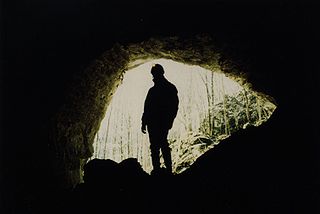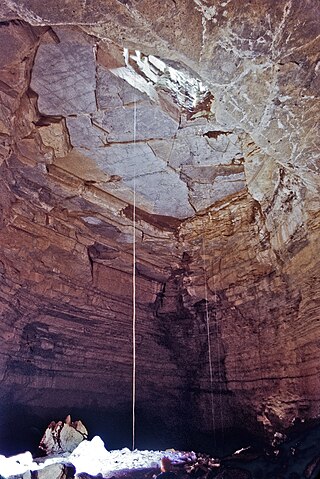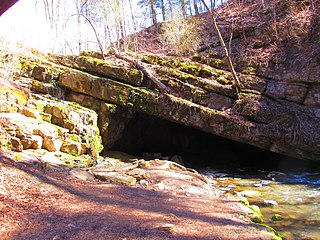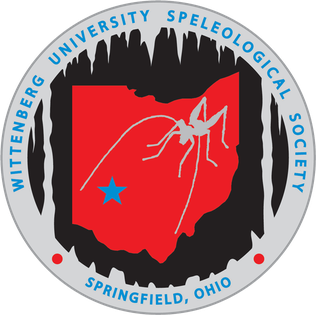
Speleology is the scientific study of caves and other karst features, as well as their composition, structure, physical properties, history, ecology, and the processes by which they form (speleogenesis) and change over time (speleomorphology). The term speleology is also sometimes applied to the recreational activity of exploring caves, but this is more properly known as caving, potholing, or spelunking. Speleology and caving are often connected, as the physical skills required for in situ study are the same.

The National Speleological Society (NSS) is an organization formed in 1941 to advance the exploration, conservation, study, and understanding of caves in the United States. Originally headquartered in Washington D.C., its current offices are in Huntsville, Alabama. The organization engages in the research and scientific study, restoration, exploration, and protection of caves. It has more than 10,000 members in more than 250 grottos.
A cave conservancy is a specialized land trust that primarily manages caves or karst features in the United States. Organizations that serve as cave management consultants to cave owners are usually considered cave conservancies. Almost all cave conservancies are non-profit organizations, but their management methodologies may be diverse. Cave conservancies often provide other services such as being advocates for responsible cave ownership and management, promoting the protection of caves, and advancing research to enhance and discover the values of caves.
The Woodville Karst Plain is a 450-square-mile (1,200 km2) karst area that runs from Tallahassee, Florida, U.S. to the Gulf of Mexico separated by the Cody Scarp.
The Woodville Karst Plain Project or WKPP, is a project and organization that maps the underwater cave systems underlying the Woodville Karst Plain. This plain is a 450-square-mile (1,200 km2) area that runs from Tallahassee, Florida, U.S. to the Gulf of Mexico and includes numerous first magnitude springs, including Wakulla Springs, and the Leon Sinks Cave System, the longest underwater cave in the United States. The project grew out of a cave diving research and exploration group established in 1985 and incorporated in 1990.
The Southeastern Cave Conservancy (SCCi) is a United States not-for-profit corporation dedicated to cave conservation, caver education, and cave management. It was formed in 1991 by a group of southeastern United States cavers. The SCCi is an institutional member of the National Speleological Society.

Wes Skiles Peacock Springs State Park is a 733-acre (297 ha) Florida State Park located on Peacock Springs Road, two miles (3 km) east of Luraville and on State Road 51, 16 miles (26 km) southwest of Live Oak, Florida. Activities include picnicking, swimming and diving, and wildlife viewing. Among the wildlife of the park are deer, bobcats, raccoon, squirrels, beaver and otters, as well as turkey, blue heron and barred owls. The park name commemorates the work of diver and explorer Wes Skiles. Prior to 2010 the park was known as Peacock Springs State Park. Amenities include a nature trail, six sinkholes, and Peacock and Bonnet Springs, with miles of underwater caves popular with cave divers. The two springs are tributaries of the Suwannee River. The park is open from 8:00 am till sundown year round.

The Leon Sinks Geological Area is located on the Woodville Karst Plain in southern and southwestern Leon County, Florida, United States. It is a mature karstic area on the Upper Floridan Aquifer. It is one of the most extensive underwater cave systems in the world and connects to Wakulla Springs.

Harrison Spring is the largest spring in the U.S. state of Indiana. It is located in west-central Harrison County, near the Blue River and just north of White Cloud.

Dos Ojos is part of a flooded cave system located north of Tulum, on the Caribbean coast of the Yucatán Peninsula, in the state of Quintana Roo, Mexico. The exploration of Dos Ojos began in 1987 and still continues. The surveyed extent of the cave system is 82 kilometers (51 mi) and there are 28 known sinkhole entrances, which are locally called cenotes. In January 2018, a connection was found between Sistema Dos Ojos and Sistema Sac Actun. The smaller Dos Ojos became a part of Sac Actun, making the Sistema Sac Actun the longest known underwater cave system in the world.

Snail Shell Cave is a limestone cave in Rockvale, Tennessee. Snail Shell Cave lies on an 88-acre (36 ha) preserve near Murfreesboro, Tennessee. Snail Shell cave is owned by the Southeastern Cave Conservancy, which has called it "one of the most biologically significant cave sites in the southeastern United States."

Hellhole is a large and deep pit cave in Germany Valley of eastern West Virginia. It is the seventh longest cave in the United States and is home to almost half of the world's population of Virginia big-eared bats. At 737 feet (225 m), Hellhole is the deepest of several caves in the Valley.

Tytoona Cave is located approximately 1-mile (1.6 km) from Arch Springs, Pennsylvania in Sinking Valley, near Tyrone and Altoona, in the United States.
Sistema Sac Actun is an underwater cave system situated along the Caribbean coast of the Yucatán Peninsula with passages to the north and west of the city of Tulum. Discovery of a connection to Sistema Dos Ojos in 2018 made it the longest known underwater cave system. As of January 2023, it is the second longest underwater cave system in the world, only surpassed by Sistema Ox Bel Ha.

Grassy Cove is an enclosed valley in Cumberland County, Tennessee, United States. The valley is notable for its karst formations, which have been designated a National Natural Landmark. Grassy Cove is also home to a small unincorporated community.
The West Virginia Speleological Survey (WVaSS) is a speleological organization and ongoing cave survey program that has gathered information and published about West Virginia caves and karst since 1967.

The Wittenberg University Speleological Society (WUSS) is a student-run grotto of the National Speleological Society (NSS) created in 1980, dedicated to the advancement of speleology. WUSS has more than 500 members, current and past students, faculty and staff of Wittenberg University, as well as community members dedicated to the scientific study, exploration, and preservation of caves and karst environments. The organization is based out of Wittenberg University in Springfield, Ohio.
Patricia Kambesis is an American caver, cartographer and educator.
Friars Hole Cave System is a cave in West Virginia's Greenbrier and Pocahontas counties. First surveyed in the 1960s, it is one of the longest in the United States and the world.











